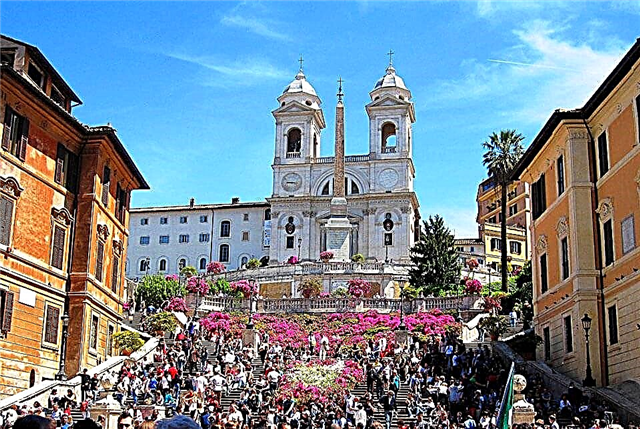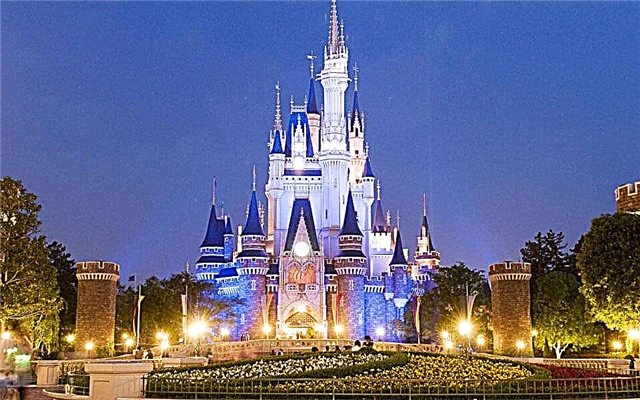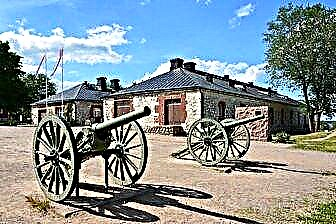Address: Russia, Moscow, Cathedral Square of the Moscow Kremlin
Start of construction: 1484 year
Completion of construction: 1489 year
Coordinates: 55 ° 45'00.1 "N 37 ° 37'01.1" E
Cultural heritage site of the Russian Federation
Content:
The Moscow Kremlin is an architectural ensemble that includes many historical buildings-monuments of Russian architecture. It also includes one of the most famous Moscow churches - the Cathedral of the Annunciation.
This oldest metropolitan Orthodox cathedral was built in the second half of the 15th century - first as a temple for the family of the Grand Duke, and later - for the royal family.

View of the Cathedral from Cathedral Square
The history of the construction of the Annunciation Cathedral in the Moscow Kremlin
The exact date of the construction of the very first version of the Annunciation Cathedral is well known to historians - it is 1397... The initiator of the construction was Prince Vasily I, the son of the famous Dmitry Donskoy. The temple was built of wood and in the old days was called the temple of the Annunciation in the Seny. The fact is that at that time the building of the temple was built near the vestibule of the prince's palace, from which it got its name. It is known that then the temple was painted by specially invited icon painters, among whom were Andrei Rublev, a certain Prokhor from Gorodets and Theophan the Greek.
In the second half of the 15th century, when 100 years have passed since the foundation of the Annunciation Church, it was decided to rebuild it. In practice, this boiled down to the fact that the old temple made of wood was demolished, and a new one was erected in its place - made of stone. Yes, at that time the invited Italian masters were already in full swing building the stone buildings of the Moscow Kremlin. It would seem that there is no need to look for someone else: after all, Italians are the world's best stone specialists! Nevertheless, at the highest level, an order was given to entrust the construction of the Annunciation Church to our architects - Krivtsov and Myshkin.

View of the cathedral from Borovitskaya street
If the reader still does not know, these are the same Krivtsov and Myshkin who built the Assumption Cathedral of the Moscow Kremlin, which collapsed during the earthquake that happened in Moscow on May 20, 1474.
However, their innocence was fully proven and proved by a special commission. Minor flaws were found, but this was clearly not enough for the accusation of the masters. By the way, in connection with the construction of the new Cathedral of the Annunciation, a very difficult task was set before our masters. This stone temple had to be precisely inscribed in the architectural complex on which the Italians worked.
The foundation date of the new church is 1484 and already in 1489 the construction work was completed. In the same year, the temple was consecrated by Metropolitan Gerontius.
Murals in the Annunciation Cathedral of the Moscow Kremlin
The history of the Annunciation Church is replete with many interesting details, and one of them is connected with the painting. Prince Vasily III ordered to paint the temple. In addition to artistic work on painting, it was also necessary to create expensive frames for icons - only from gold and silver. It is reliably known that the painting of the temple was brilliantly executed by the famous icon painter of that time Fyodor Edikeev. But whether the old icons by Rublev were transferred to the new church, or their exact copies were made, is hard to say for sure.

View of the south facade of the cathedral
But the most interesting thing is different - on the porch of the Annunciation Cathedral, the murals include images of philosophers from ancient Greece - the well-known Ptolemy, Zeno, Aristotle, Plutarch, Plato, Socrates and Thucydides. Pagan philosophers are depicted on the walls of the temple with scrolls in which sayings are written as close as possible to Christian ones. There are many versions about this painting. In one, it is believed that these images are a kind of innovation by Fedor Yedikeev, on the other - adherence to the traditions of Greek primary sources: it is no secret that the first Russian metropolitans were Greek in origin. And they sacredly honored their sages, even if they were not Christians.
The history of the name of the Annunciation Cathedral of the Moscow Kremlin
Prince Vasily III did not spare state money for the construction of a new church, and this is felt in everything - in expensive church painting, in the manufacture of icon frames from silver and gold. By the way, a lot of gold was spent on gilding the domes of the temple. There was so much gilding and it glittered so brightly and beautifully in the sun that the third name, "Golden-Domed" (after the Annunciation and "in the Tsar's courtyard by the vestibule"), was assigned to the temple.

View of the cathedral from the Archangel cathedral
If we continue to talk about all the splendor of the temple, then it should be noted and its floors. After all, they are laid out entirely of precious stones - agate, marble, jasper... According to one of the historical versions, Tsar Alexei Mikhailovich received the jasper as a gift from the Persian Shah.
Russian sovereigns were very fond of and patronized by the Cathedral of the Annunciation. After the construction and consecration of the temple during the time of Vasily III, this temple came under the tutelage of his son Ivan the Terrible.
The history of the Annunciation Church from the time of Ivan the Terrible to Napoleon
In 1547, a frequent occurrence of that time happened in Moscow - a strong fire. Since the temple was made of stone, the fire did not completely destroy it, but the damage was still done. Ivan the Terrible invited the masters who almost completely renewed the painting of the church, which had been badly damaged by the fire. Also, Ivan the Terrible built a covered gallery on the left side of the church, and installed the image of the Annunciation, transported from the Yuryev Monastery in Novgorod. Tradition says that standing on the porch of the Cathedral of the Annunciation, Ivan the Terrible saw a comet of an unusual shape - in the form of a cross. Having said that this was a sign of his death, literally a few days later the king was gone.
The son of Ivan the Terrible, Tsar Fyodor Ioannovich, fell under the impression of the domes of the cathedral burning in the sunlight so much that he ordered a cross to be cast for him from pure gold.

Cathedral domes
Napoleon was looking for this cross for a very long time and unsuccessfully, when Russia shuddered from the invasion of hordes of soldiers of his army. And fate seemed to mock him - he confused the cross on the bell tower of Ivan the Great, only gilded, with a gold cross from the dome of the Annunciation Cathedral!
Cathedral of the Annunciation and ... chimes
We can say that not only Moscow, but the whole of Russia owes one most interesting fact to the Annunciation Cathedral - this is where the history of the famous chimes begins.... In 1404, Lazar Serbin, a skilled craftsman and at the same time a monk from Mount Athos, created a mechanical clock with a human figure. This clock was installed on the tower of the grand ducal palace, which rang the bell after every hour. The watch was wildly expensive at that time - history even told us its exact cost: 30 pounds of pure silver. In fact, this was the first Moscow clock on an urban scale. Then the clock was installed on the Spasskaya Tower (much later): in 1624 it was designed and manufactured by domestic craftsmen Zhdan and Shumilo in collaboration with the Englishman Christopher Galovey.
Annunciation Cathedral Museum of Our Time
The last time the Annunciation Cathedral was destroyed in 1917, when the Kremlin was fired upon from cannons. One of the shells almost completely destroyed the famous porch of Ivan the Terrible, where he saw the comet, the harbinger of his death.

When the Bolsheviks came to power, their government moved to Moscow in 1918. The Annunciation Cathedral, like the Moscow Kremlin, was closed. Now the cathedral practically does not function as a church building; there is a museum on its territory.











